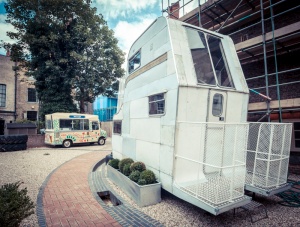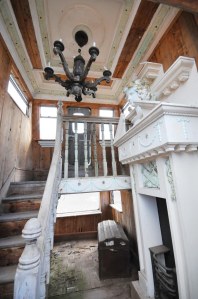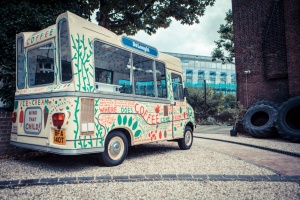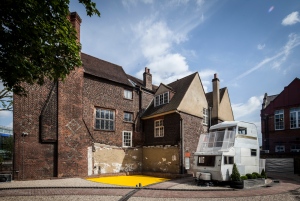Next to Sutton House – the oldest house in east London, built 1535 – was a scuzzy yard where old cars rotted amid the rubbish and weedy sycamores. That was pretty typical of odd corners and backyards in suburban Hackney in the 1980s.

But things are changing. This site is now becoming a wonderland of vehicle sculptures and plants to keep kids entertained.
The Breaker’s Yard will be a garden next to the Tudor brickwork of the house and is due to open at 1pm on 12 August 2014. It has been designed by Daniel Lobb, an established garden planner. The entrance will be marked by special gates, made with hundreds of old toy cars donated by local celebrities. There will be pots of plants made from old tractor tyres and a watercourse running though the length of the garden, then disappearing down an old well.
The garden also contains Daniel’s 1998 remarkable sculpture The Grange, which resembles a two-storey caravan on the outside and a mini-stately home on the inside.


Also in the garden is a 1980s ice-cream van, decorated by Sir Peter Blake’s daughter Rose, which will act as a playful shop and provide refreshments.

The educational charity The House of Fairy Tales is to engage school children and families in the garden. Their entertainment is due to be supported by a network of “creative artists” – so let’s see what they come up with!
Of course, Sutton House has a very Hackney history. Although it started as a grand house known as the “Bryck Place”, built of brick when most places were wattle and daub, it has been through the mill over the years. It was built by Sir Ralph Sadlier, who was King Henry VIII’s ambassador to Scotland at one point and a colleague of Sir Thomas Cromwell. Besides Tudor courtiers it has housed Huguenot silk weavers, a brewery, the local church institute and squatters. All are represented in what you see in the house today, from linen-fold oak panelling to squatter’s murals. Now the garden will represent a car scrapyard of the late twentieth century!
What’s not so well known is that the soil under the site will have suffered from contamination by engine oil, brake fluid, battery acid and old asbestos brake pads. Therefore the design seals off the soil and uses imported compost to support the plants.
I look forward to seeing the plants in place. But the garden in any event represents and achievement of the National Trust, the mayor of London’s Pocket Parks project, the Royal Society of Wildlife Trusts and the waste company Biffa, which have all contributed cash and organisation to the Breaker’s Yard project.

